Climate finance & Climate reparations Digging Deeper: Conversations on Mining and Just Transitions
Topics
Explore how debt burdens and global economic structures impede a just transition in the Global South. Unpack decolonization, green industrial policy, and climate reparations for equitable, sustainable futures.
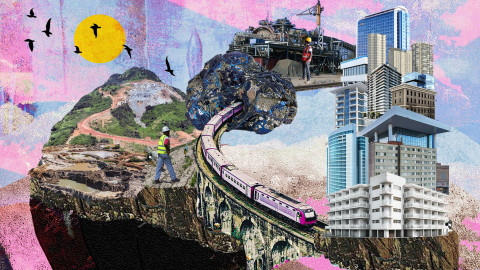
Illustration by Fourate Chahal El Rekaby
Reforming global finance for just mining
Katie: Thank you so much Fadhel, for joining us. The debt burden of countries in the Global South is being used to justify ‘critical’ and other raw material extraction for the ‘green transition’, with mining companies are framing this as an opportunity for countries to get out of debt. How does the global debt and finance system or the global economic system drive destructive mining? How is it blocking a just transition? What transformations are needed in the global financial architecture to create the conditions for the possibility of ‘just mining’?
Fadhel: Let’s start with the big picture, which is the global economic architecture. This has four basic pillars: the global financial architecture, that’s the World Bank and the IMF. Then you have the global trade and investment architecture, the rules of trade and investment, primarily under the World Trade Organization (WTO). Then you have the global taxation architecture, which for the longest time was in the hands of the OECD countries, and now, thanks to the Africa Group last year, we’re finally in the process of moving that from the hands of the OECD into the UN system with the UN Framework Convention on Taxation.
So that entire global economic architecture - finance, investment, trade and taxation - was, from a Global South perspective, not designed by us or for us. It was designed during colonial times for colonial economic purposes which was, primarily extraction from the Global South. How can we expect a colonial architecture to deliver non-colonial results? That architecture was not designed for a just transition, development or democracy. It was extractive, abusive, violent and is delivering very violent, abusive, hierarchical results. So, in talking about a just transition, development and human rights, we are not paying enough attention to the overarching architecture.
The colonial role that was imposed on Africa and the rest of the Global South can be summarized in three major components. Firstly, we are supposed to produce cheap raw materials to be used in the Global North, or by industrialized countries. We still play that role today. Secondly, we are supposed to be the consumers of technology and industrial outputs of Northern countries. We still play that role today. Thirdly, and most importantly, we are supposed to be the place where obsolete assembly-line manufacturing and technologies no longer needed in the industrialized world, are outsourced under the label of ‘job creation’, ‘development’, ‘cooperation’, and ‘technical assistance’. But effectively, that locks us permanently at the bottom of the global value chain, the bottom of the hierarchy. We still play those major colonial functions today with predictable outcomes in terms of development, democracy and human rights.
That is the starting point for the transformation that needs to happen. It requires undoing the colonial roles that were imposed on us, which means transforming that global economic architecture, not just reforming it, including the financial, trade, investment and taxation architecture.
That architecture produces one of the main obstacles to the just transition, which is the external debt burden of the Global South. External debt is a serious problem because it eats up the ‘fiscal policy space’ that could be used to invest in health, education, climate adaptation or any other Global South priority.
What is the root cause of this external debt? There are three major sources: food imports, energy imports and imports of high value-added products. These are, by design of the global economic architecture, structural traps for the Global South. So there will be no transformation unless we address the root causes of the lack of food sovereignty, energy sovereignty and technological sovereignty.
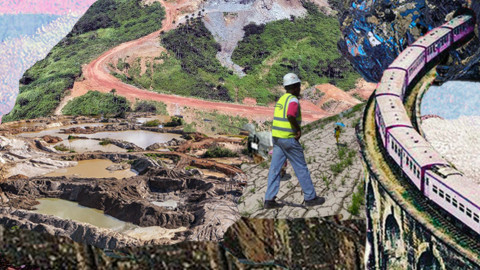
Raw materials and the Global North-South divide
Katie: Thank you for that big picture. The role of the Global South as consumers of ‘obsolete labour processes and technologies,’ and exporters of raw materials gives an idea where mining fits in the picture, but could you say a bit more about that?
Fadhel: Yes, today for example, there is almost a panic in the Global North about critical minerals. If you look at a map of the world, the vast majority of critical raw materials is located in the Global South. They are a key resource for high tech products, renewable energy infrastructure and consumer products for the 21st century economy, and military technologies, of course. So, any country ‘industrialising’ in the next 100 years will need access to those resources.
That is why the industrialized world wants to maintain its position at the top of the existing colonial hierarchy, and keep the Global South at the bottom, by continuing to assign them the role of cheap raw material source, consumers of technology, and bottom of the value chain. Mining is at the heart of that.
The key blocs that are competing economically and geopolitically are the US, China and Western Europe. The US and Europe were asleep for the last 30 years regarding access to critical mineral mining and processing, while China managed to dominate. China mastered the technology for refining critical minerals to the point that Europe and the US are dependent on it now.
But the Covid crisis and the Ukraine conflict were a wake-up call for Europe and the US that disruptions to supply chains, especially in strategic sectors with civilian and military applications, critical minerals were now considered ‘critical’ and not just ‘minerals’. That sparked a whole reindustrialization to bring home some of the key components of the global supply chain to Europe and the US, meaning they now need to access mines in the Global South and build infrastructure for processing critical minerals in countries where they have strategic partnerships, including security partnerships, or even bring home the whole value chain, extracting and refining in the Global North.
When we look at the decarbonization and economic development plans of Europe, the US and China - the EU Green Deal, the US Inflation Reduction Act (IRA) –which is the Green Industrialization Strategy for the US, or China’s Belt and Road Initiative (BRI), all these are growth programs, not degrowth programs. They assume that they will have access to all the critical minerals they want from the Global South to decarbonize transportation and electricity, to continue consumerism and the obsession with growth and planned obsolescence. If you assess the volume of critical minerals available on the planet, considering the growth visions of China, Europe and the US, there would be nothing left for the Global South to develop. That is the elephant in the room.
So if the Global South actually puts together a real development strategy, a green industrialisation strategy for itself, to use its own resources to manufacture and deploy the building blocks of development - renewable energy infrastructure, clean transportation infrastructure, clean cooking infrastructure - that would force Europe, the US and China to revise their development plans and growth-driven model. It would force them to start investing in research and development to reduce the use of physical resources, and to start thinking carefully about designing circular economies, reducing waste and consumerism, and a degrowth vision, consistent with the physical resources available.
There is an implicit assumption that the Global South should not do that. It’s all about extraction from the Global South, reproducing the same hierarchy. This is why, from a Global South perspective, we cannot decarbonize a system that has not been structurally and economically decolonized. If decarbonization is decoupled from decolonization it is going to produce ugly results for us in the Global South and for the whole planet. That is why we need to link the two if we are serious about a just transition and living within planetary boundaries.
Tensions between development and extractivism
Katie: Thank you for those incredibly important points, and focusing on how the agency in a degrowth vision can come from the Global South. Could you say something about the different landscapes and territories within the Global South? For a lot frontline communities, it does not necessarily make a difference whether extraction is ultimately for the global North or for wealthy people in their own country, the damage of extractivism is the same. What are the potential tensions around national ‘development’ projects and people living in the ‘peripheries’ of a nation?
Fadhel: Yeah, absolutely. When it comes to frontline communities in mining areas, sometimes the abuse and damage is actually caused by national mining companies, not foreign investors. In recent years, the Colombian Ministry of Environment, is modeling an interesting framework for engaging with frontline communities. Colombia is a major exporter of fossil fuels. Last year at (the UNFCCC) COP, Colombia endorsed the ‘Fossil Fuel Non-Proliferation Treaty Initiative’, which basically says that we are on track to extract and burn more than double the amount of fossil fuels that we can based on the carbon budget. So we need to immediately stop adding additional fossil fuel infrastructure, and rapidly phase out existing fossil fuel infrastructure under a just and equitable transition framework. Countries like Colombia - Global South exporters of fossil fuels - should be allowed a just transition that will allow them to diversify their economies away from excessive reliance on fossil fuels.
Colombia is actively engaged in designing what a just and equitable transition would look like for them. They are developing alternative economic structures that will help the country industrialise without fossil fuels, leverage critical minerals they have to design green industrial policies, and create the jobs and economic diversification they need. That means engaging directly with frontline communities in mining areas to have a serious conversation about how to extract minerals from those communities under a just transition framework.
In the past, the national mining company has extracted coal, oil and other minerals from those same communities, and caused significant damage. So you can imagine the low level of trust in the government that is now saying: we will do the same thing, but now it’s called ‘just transition’ and ‘green’, and it will be good for you. No-one is going to buy this, unless you do the genuine engagement to build trust, and design and set the terms of extraction, prioritising development and quality of life improvement, human rights and environmental rights protection, in enforceable terms that the community can trust and build on. That means certain territories will be designated ‘unminable’ for human rights, environmental, ecological and biodiversity reasons, and communities have, essentially, the right to say no. This doesn’t mean this framework in Colombia is perfect, but it’s a starting point.
The other important point is that we have to be very clear that no country in the Global South can industrialize alone. The economics of industrialization requires ‘economies of scale’, which means you have to produce a large volume of a particular unit for the cost per unit to decline, the quality to improve, efficiency, and for research and development and innovation to kick in. The benefits of industrialization can only happen at scale. If you are a small country, you don’t have the internal market demand to allow you to industrialize, so you have to rely on exports, and good luck competing with Japan, Canada, the US, Germany and China. You think that you are industrializing, but in practice, you are manufacturing a small component in somebody else’s industrial policy. That’s not real industrialization.
On the other hand, if you imagine a regional bloc of five, ten, fifteen, twenty countries, with a complementarity of resources and capabilities, collectively they will have the market size to industrialize, and have the economies of scale of say 500 million consumers. Then you can have an industry and start building horizontal linkages between different components of the supply chain.
I’ll give you one example, from European history. When Boeing dominated the industry there was no way France or Germany alone could create Airbus. They were just too small. So, Airbus had to be created as a pan-European joint industrial policy, with pre-negotiated distribution of the value chain, of the value-added content, terms for commitment to research and development and so on. Collectively, the European countries that created Airbus had the complementarity of resources and capabilities to compete with Boeing.
This is what we are talking about in the Global South. We want joint industrial policies to manufacture and deploy the building blocks of development, starting with a renewable energy system, clean cooking infrastructure for the 950 million people in Africa who are inhaling toxic fumes on a daily basis; to manufacture and deploy clean public transportation to link our cities and our economies to create the logistical infrastructure for our development. Just those three industrial policies will create hundreds of millions of jobs in Africa, and the rest of the Global South, and will actually create the building blocks of development. So these are basic pillars, but no country can do it alone.
So now, linking it back to mining and extractivism, when you have blocs of countries engaged in joint industrial policies, that will involve mining and mining technology. China dominates the mining industry today. If you are a small country like Malawi, with GDP of 20 billion dollars, and you are engaging with a country of 20 trillion dollars, like China, what can you negotiate in terms of engagement in the mining industry, prices, human rights, environmental rights, labor rights? Very little bargaining space, right? But if you are a bloc of countries operating under a joint industrial policy and a joint mining strategy for development, then you will have a chance to bargain. So then the burden is on that bloc of countries to engage with their people in defining the terms of industrialization.
When the Europeans organized a joint industrialized policy, it was a pre-negotiated distribution of the value chain. You can pre-negotiate and pre-design the distribution between capital and labour, the terms of extraction, the human rights, environmental, labour standards. Then as a bloc, you go to a country like China and say: these are the terms of engagement moving forward. We negotiate as a bloc, not as individual communities. Because if you negotiate as a small mining community, you get nothing, that’s the reality. But if you negotiate as a bloc of countries, you have a better chance.
Decolonization and extractive infrastructure
Katie: I feel like this really shows how the project of international scale decolonization cannot be separated from local and national democratization processes, right? What are your thoughts on infrastructure? It’s probably a little outdated now but Walter Rodney already showed how a huge amount of infrastructure on the African continent was created with this very extractive goal, so that transportation, shipping and other infrastructure serves international export rather than intra-regional trade.
Fadhel: Absolutely. You are getting to the serious issue here. I remember seeing maps of the African continent transportation system, pipelines, railroads or electric grids. These look like colonial invasion maps that the military would use. You can see the bleeding veins of the continent, the extraction infrastructure. And day one after independence, whatever government comes into office, with all the patriotic, post-colonial priorities, you’re not going to scratch the entire extractive infrastructure and start building a new one. What you do is you work with what you have, and then you tend to add to it. So now you have a national government, not a colonial government, basically extracting from the same mines, using the same colonial roads and railroads, going to the same colonial ports, typically shipping to the same final user in the Global North.
That is why I talk about the unfinished business of decolonizing our economies. There are several challenges: one is literally, the physical infrastructure. Second, you have the challenge of acknowledging and recognizing that this is a problem. This is decolonizing the mind and saying: ‘we are continuing the same colonial extraction and abuse of our own system’. And then, what do we do now? It’s a monumental task to undo that structure because you cannot stop everything and start from scratch. How do you feed your people, meanwhile? The next step is recognizing that it’s not just you, all of your neighbours and the continent have the same challenge. So you start thinking collectively: how do we undo this system?
And if you’re successful in getting to that stage, you realize real industrialisation and escaping colonial structures requires building the foundations for development and prosperity, starting with energy, transportation, clean cooking. These are massive manufacturing and industrialization opportunities, and as a bloc of countries, you have all the natural resources and strategic minerals that you need for to transform your economy. The African continent has the youngest labour force on the planet and the economies of scale needed. You are then missing one thing: access to the technology to manufacture and deploy that infrastructure.
This is where strategic partnership comes in. The technology we need to manufacture solar, wind, geothermal, highspeed rail, clean cooking infrastructure is readily available in the industrialised world. The International Renewable Energy Agency (IRENA)’s, report from a year and a half ago said that with existing renewable technology, by 2040, Africa can produce 1000 times its anticipated energy needs with renewables and completely replace the continent’s fossil fuel exports. One thousand times! Meanwhile, Africa attracts less than 2 percent of global financial flows for renewables. It sounds absurd. And we have no access to the manufacturing for renewables infrastructure that will allow us to unleash the continent’s actual development potential.
Why is the continent with the biggest potential for renewables unable to attract the technology and resources that are plentiful in the global economy? It’s not by accident. It would be a major threat to the existing colonial hierarchy. Because imagine Africa’s potential with renewable energy. It’s like taking the power of OPEC, multiplying it by a thousand.
So, on the African continent, we see the tremendous potential of renewable energy, as a win-win, but the Global North perceives it as a risk to be managed and eliminated. That means no transfer of technology for what we call Pan-African Industrial Policy. Technology is not going to come from OECD countries. So how can we move forward?
Imagine that we have a bloc of 20 or 30 Global South countries that can co-design a joint industrial policy, with a complementarity of resources and capabilities, pre-negotiated distribution of the value chain within that bloc, and pre-defined terms for labour rights, environmental rights, human rights and so on. Then we have everything we need, except for the technology. We already know the Global North is not interested in sharing or partnering with their technology. So if that bloc goes to China, which has the entire value chain that we want to replicate, and says: we’ll give you the bargain of the century, if you transfer technology to partner with us in this joint industrial policy, on our terms that we’ve pre-defined, here is what we give you in return. In 10 to 15 years, you double your industrial footprint and your geopolitical weight globally. And you secure your access to these precious minerals that everybody is panicking about. In addition to that - and this is thanks to the new trade restrictions that Europe and the US are imposing on Chinese high-tech products - we offer you, potentially, the biggest market for your high-tech products.
The Global South collective market is bigger than the US, Europe, Japan and Australia combined, but we don’t have a strong purchasing power yet, but if we truly industrialize, we will have the purchasing power, creating the biggest market on the planet. China will accept that bargain, I guarantee you.
Just triggering this process of real industrial policies immediately gives us the second bargaining chip to change the conversation with the Global North. And then we go to a country like Germany, or France, and say: look, we give you the same bargain we just gave to China, as joint-venture partnership to transfer technology, to manufacture and deploy wind turbine technology in the Global South, on our own terms, or high-speed rail technology. Let’s partner with your technology and our large market. And if they say ‘no, we don’t transfer technology’, we say ‘ok, fine, China has the same technology’. At that point, OECD countries cannot say: no, we don’t transfer technology, because they will be left out.
So the idea of this geopolitical bargain is not to position China at the top of the hierarchy, but rather to reposition the Global South at the center of a new international economic order, where we become the arbiter of this new geopolitical and economic map. That becomes the real multi-polar system that we want to see, with real industrialization and development in the Global South. And now that the Global South is using its critical minerals for development on its own terms, it forces the major economic blocs, China, Europe and the US, to rethink consumerism, energy use, energy waste, planned obsolescence, and start thinking about degrowth and circular economy, under a new multipolar, stable, peaceful international economic order.
The labour component is also extremely important. In the Global North, this is often framed as: this is going to be a loss for workers and middle-class people in the Global North, when it’s actually not. If we engage in real industrialization in the Global South, our workers will be busy manufacturing and deploying the building blocks of development and prosperity, manufacturing high value-added products for the Global South. Which means our workers are no longer available to do the assembly-line manufacturing for consumers in the Global North, which means Global North workers’ jobs are not out-sourceable anymore. Their jobs are protected with real industrial policies in the South. It is a win-win for workers in the Global North. And now the focus is shifted towards the real issue, which is how does the Global North create a new social contract with their middle class when jobs are lost to automation, robotics, and AI. At that point the narrative about immigrants and workers in the Global South “stealing your jobs” is no longer valid. Instead, the focus is shifted to questions of income distribution between workers and shareholders, and the role of the state in guaranteeing the right to a job, universal public services, and decent incomes for all.
Building alliances
Katie: That’s a powerful point about the possibility for alliances between labour movements in North and South. What role do you think people’s movements have to play in pushing for this?
Fadhel: Quite a bit of the work that my colleagues and I have been doing in the last two years is to socialize an alternative framework for energy and climate policies in the Global South with civil society groups, Global South think tanks and organizations across the entire spectrum. Not just those thinking about energy, climate and development, but a movement of movements under an overarching vision.
The most challenging step, is to bring this to policymakers and actual governments at the highest level, to start thinking in that way. And it’s not that most governments don’t understand it, but they have a whole dashboard of vulnerabilities that prevents them from taking action. To get to this Pan-African Joint Industrial Policy, you need a critical mass of countries, with leaders at the highest level: presidents and prime-ministers, who understand these linkages, and are ready to engage in serious conversations with other countries to form that bloc. And this is like playing with fire, right? You’re engaging in a geopolitical bargain that is designed to disrupt existing hierarchies. It’s not going to be well-received, especially by OECD countries.
You have to be fully ready as a bloc before walking into the lion’s den. If you walk in there unprepared, you get eaten alive. That’s why this idea is scary to policymakers. But as a bloc, you can design strategies to minimize your collective vulnerability, leverage your collective strength, disrupt the system and reposition yourself.
My colleagues and I have opted to share this vision publicly, rather than secretly, because you have to socialize this massively with civil society organizations, think tanks, political movements, media and social movements. You have to create the push from below, and that’s the best way to protect this vision, to make sure that everybody knows it, both in the Global South and North because we have tons of allies in the Global North who want to see a better world and live within the planetary boundaries, and see real development and prosperity in the Global South. Once it’s on the table, and we have the technology, finances, resources, political will, and social movements, we identify who is standing in the way and name, shame and displace those obstacles.
That’s it in a nutshell. Easier said than done, but that’s why it’s called the struggle, right? And that’s the unfinished business of decolonizing the Global South.
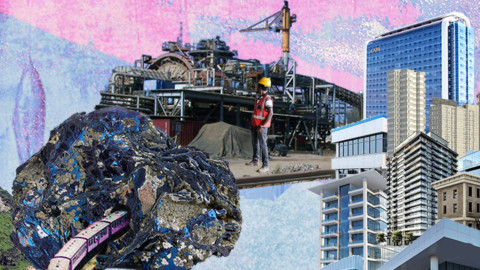
Climate reparations
Katie: It is a very powerful vision. Can you tell me a bit about how this fits with current global campaigns for reparations?
Fadhel: When it comes to climate finance, from a Global South perspective is very straight forward. If you take the science and the economics seriously, we have a carbon budget. Countries in the Global North have exceeded their carbon budget by far, and the Global South didn’t. The countries that exceeded their carbon budget have a climate debt. The concept of debt is very straight forward in economics, finance and the law. If I owe you 100 dollars, I pay you 100 dollars. We can negotiate the payment plan, but at the end of the day, I give you 100 dollars and you don’t have to give me anything in return.
However, in the climate finance space, that’s not how it works. Instead of me giving you 100 dollars, I give you 3 dollars and tell you exactly what to do with it: set up conditionalities, and if you don’t follow the conditions, I cut off the instalments of 3 dollars. I give you 25 cents every 6 months. And then I feel bad because you clearly need more than 3 dollars for your climate finance, so I’ll lend you 7 dollars, charge you interest, with conditionalities to set up a debt trap for you. And then, you clearly need more than that for climate finance, so I’m going to give you 10 dollars, but you have to give me your forest, for carbon offsets, in other words, pollution permits so I can continue my emissions and use your forest as a carbon sink. Now you have to protect your forest. Protect it from whom? From the indigenous people who are the custodians of the forest for thousands of years. You have to displace them. We call that climate finance.
And then I’m going to bring my companies to invest another 20 dollars in your economy to produce green hydrogen for me, not for you, but you have to de-risk this investment for them, giving them all kinds of concessions to guarantee their profits and greenwash the whole thing. At the end of the day, you’re sitting there and saying: wait a minute, where’s my 100 dollars? You’re supposed to give me 100 dollars, right? I’m not supposed to give you my forest, or my hydrogen, or borrow from you. This is the reset we want to have in the climate finance discussion.
Climate finance is about climate debt, which means you pay that debt. That’s what we call climate reparations. It should be paid in three categories: 1. grants, not loans. 2. it needs cancellation of climate-related debts, not debt rescheduling to stretch out the payments into the future. There’s a whole case to be made for debt cancellation outside climate space of course, and this should be part of the conversation about how to create the fiscal policy space to allow us to develop our economies, climate resilience and adaptation. 3. and most importantly: transfer of life-saving technology. I use the term life-saving intentionally. Life-saving technology to allow us to manufacture and deploy the infrastructure that we need: renewable energy, clean cooking, and clean public transportation infrastructure, and the resilience and adaptation infrastructure that we need for water, sanitation, agriculture and so on. That is the climate reparations framework that will allow us to simultaneously decolonize and decarbonize. Any other framework using the decarbonization rhetoric but has no interest in decolonizing the economic structures cannot be the framework for producing just transition, human rights or democracy. It’s just greenwash, rinse and repeat of the same colonial relations.
Closing thoughts
Katie: Are there any closing thoughts you want to share?
Fadhel: We talked so much about green industrialization, but there’s also the threat of greenwashing green industrialization to reproduce the same colonial hierarchy. At the last COP, Kenya and other African countries proudly announced their green industrialization partnership with the Global North. But if you look at the details, it’s not real green industrialization, it’s green extractivism.
To give some background, Germany’s alternative to reparations for genocide in Namibia was ‘development’. The Namibian government accepted this deal and now we have massive investments, primarily from Germany in this new flagship ‘green industrial zone,’ relying on producing renewable energy, green electricity, and green hydrogen which requires a massive amount of water, but Namibia has no water to spare, hence the need for seawater desalination, which has its own negative ecological impact. The land use to produce solar and wind to produce green electricity to produce green hydrogen is displacing people from their land, the descendants, by the way, of the victims of the genocide.
But what is this green industrial zone supposed to manufacture? It’s actually outsourcing obsolete assembly line manufacturing that is no longer needed in the EU to be assembled in Namibia’s green industrial zone, with low-cost energy and low-cost labour, then shipped back to EU consumers, except those products are now ‘green,’ so they don’t pay a CBAM tax – the Carbon Border Adjustment Mechanism – the carbon tax. So the green industrial zone and CBAM are two sides of the same coin, designed to be an inflation management tool for the EU, keeping the cost of goods low, and acting as a trade weapon against EU competitors who don’t have green industrial zones yet. This whole thing is labelled green industrialization, climate finance and development for Namibia, but effectively, it’s extracting Namibia’s resources and locking Namibia at the bottom of the global value chain, again.
The UK is also about to introduce it’s CBAM, same for the US, Canada and Japan. Soon you’ll see a flood of green industrial zones in the Global South designed to recreate the same hierarchy, all labelled as climate finance and green industrialization.
So, not all ‘green industrialization’ is decolonizing the Global South.
Katie: That is a really important point as we see the term green industrial policy blowing up in the last couple of years, the term itself is becoming a space for contestation, at risk of green grabbing.
Digging Deeper
Full dossierConversations on Mining and Just Transitions
This series of conversations is aiming to explore challenging questions around mining and the energy transition, and the solutions that social movements are putting forward.
-
Digging Deeper An Introduction
Publication date: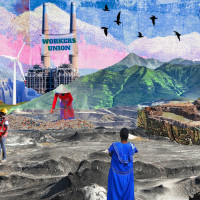
-
Ending corporate impunity & realising the Right to Say No Digging Deeper: Conversations on Mining and Just Transitions
Publication date: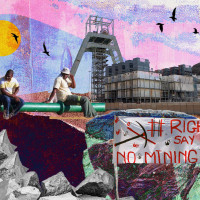
-
Artisanal and Informal Mining Digging Deeper: Conversations on Mining and Just Transitions
Publication date: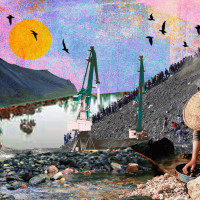
-
Mining, Land and Territories Digging Deeper: Conversations on Mining and Just Transitions
Publication date: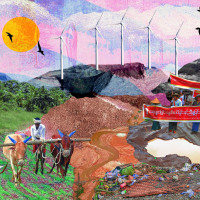
-
Right to Repair and Circular Economy Digging Deeper: Conversations on Mining and Just Transitions
Publication date: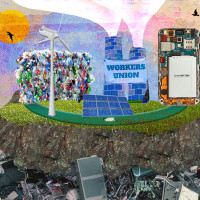
-
Green Industrial Policy Digging Deeper: Conversations on Mining and Just Transitions
Publication date: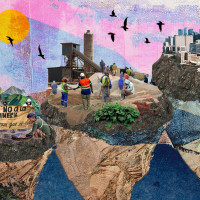
-
Climate finance & Climate reparations Digging Deeper: Conversations on Mining and Just Transitions
Publication date: